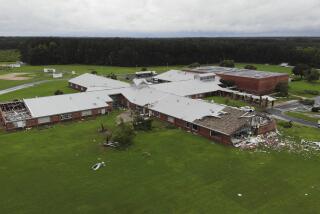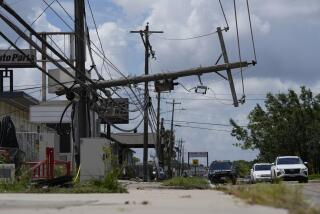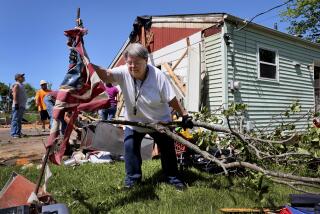Tornado wreckage revealed in Arkansas, Kansas, Oklahoma
Tornadoes, as one of nature’s most unpredictable disasters, can strike pretty much anywhere across the central U.S., and come in a dizzying variety of shapes and sizes.
Yet the physical damage they leave behind often looks very much the same — denuded trees, shattered brick, piles of soggy wood. It’s that kind of damage the National Weather Service uses to help calculate the strength of a twister, and it’s that kind of wreckage that was widely displayed on social media after the worst tornado outbreak of the year struck several states Sunday.
At least 16 people were killed in Sunday’s storms, with 14 of those killed near Little Rock, Ark., as a twister or series of twisters scoured a path through the central part of the state. On this National Weather Service graphic of severe storm reports, you can see the endurance of the Arkansas storm reflected in the line of red dots (signifying the sighting of a tornado) moving northeast through the state:
In Arkansas, the twister crossed Interstate 40, a crucial trucking artery out of Little Rock, while drivers were still on the road, then thrashed the town of Mayflower before continuing northeast to Vilonia and beyond. The National Weather Service reported that Arkansas Game and Fish Commission headquartered east of Mayflower had been destroyed.
“It’s very, very, very bad,” one official radioed Sunday on an emergency channel while driving down I-40, reporting a ghastly scene of flattened tractor-trailers and flipped cars. “People are in stretchers.”
Another official radioed, “We’re hearing people yell for help.”
Rescue efforts then continued through the night, with the death toll mounting.
Carly Dear, 22, a University of Central Arkansas student in Conway, arrived on the scene Sunday evening around 8 p.m., and the damage was so bad that she couldn’t tell whether the wrecked cars she saw had been tossed off the highway or had come from a local junkyard.
“The surroundings changed immediately, you could tell where [the tornado] started, what it went through,” Dear told The Times. “The power lines were chopped in half, the trees were chopped in half, the RV park was completely gone, we couldn’t tell where we were because everything was just scattered.”
“We could still see how bad it was even though it was really dark,” Dear said, adding, “the strength of the tornado threw the entire frame of a mobile home over the access road, almost landing on I-40,” which she posted a photo of:
By morning, the extent of the damage north of Little Rock started to come into focus.
Lindsey Robinson, of Dallas, posted this photo of the scene in Mayflower along I-40:
Mayflower had been hit hard.
Scene at #tornado in mayflower, AR pic.twitter.com/Cu8CEea4pj— Molly Hennessy-Fiske (@mollyhf) April 28, 2014
AR #tornado survivors pic.twitter.com/VOb1Fm7NJW— Molly Hennessy-Fiske (@mollyhf) April 28, 2014
Nearby Vilonia had also been hit, as seen in this photo shared by Casey Collings.
But Arkansas wasn’t the only state to suffer serious damage. Sunday’s twisters also raked rural areas in Nebraska, Iowa, Missouri and Mississippi, but the sister towns of Quapaw, Okla., and Baxter Springs, Kan., just six miles apart, both suffered near-direct hits.
Quapaw appeared to have been hit first, with emergency officials telling the Los Angeles Times that the town’s north end had been heavily damaged and its fire station destroyed.
David Strassle posted this photo of the Quapaw damage to Instagram:
Baxter Springs was then heavily damaged. Scott Fernandez, 38, an amateur storm chaser from Detroit, told The Times he was watching from about a mile away when the funnel cloud descended and struck Baxter Springs.
“Once we got in there, there was a lot of debris across the main road — the damage path had come from south to north, going northeast,” Fernandez said. He said he saw one house with a tree on top. “The family was outside,” Fernandez recalled. “One of the girls had a cut on her leg — the mother had five kids, and their dog — and they were all sitting in the living room of that house when the sirens went on, and then the tree fell on their house. ... It was a miracle they had all survived that, because it was pretty well destroyed.”
Jessica Byler, of Baxter Springs, told The Times that she cowered with her family when the storm hit, posting this sequence of photos from before and after the tornado struck.
Thirty-four injuries were reported in Kansas, with 60 to 70 homes and 20 to 25 businesses destroyed in Baxter Springs, according to the Kansas Division of Emergency Management.
More to Read
Sign up for Essential California
The most important California stories and recommendations in your inbox every morning.
You may occasionally receive promotional content from the Los Angeles Times.











